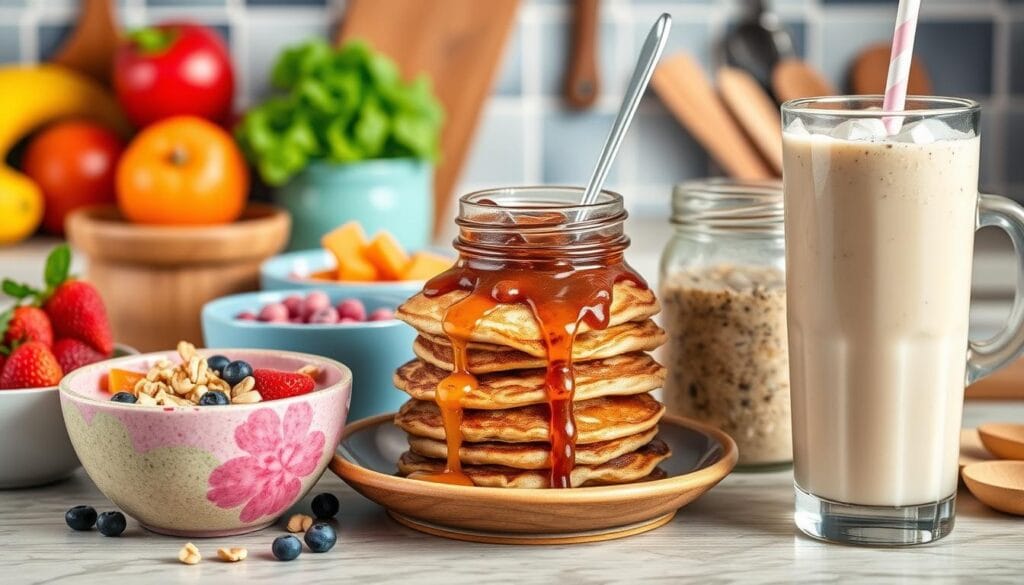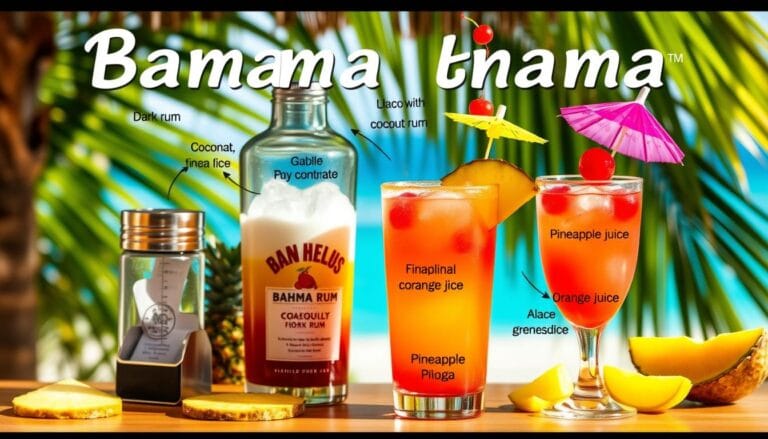Easy Protein Powder Recipes to Try at Home
Protein powder recipes are a game-changer for busy professionals. If you’re short on time but need a protein boost, making a protein-rich meal can feel challenging. Don’t worry! This article will show you how easy and tasty it is to incorporate protein powder into your diet
Protein powder is super versatile. You can use it in many recipes, from breakfast to dessert. It’s great for boosting your workouts, helping muscles recover, or just adding nutrition to your meals. These easy recipes will become your favorites.

Table of Contents
Key Takeaways
- Protein powder can be used in a wide range of recipes beyond just smoothies.
- Incorporating protein powder into your diet can help increase your overall protein intake, which is important for muscle repair, weight management, and overall health.
- This article will explore various easy and delicious ways to use protein powder in homemade recipes.
- The recipes cover a variety of meal categories, including breakfast, snacks, pre-workouts, and desserts.
- The recipes offer both traditional and unique flavor combinations to cater to diverse taste preferences.
Understanding the Basics of Protein Powder in Recipes
Protein powder is now a staple in home cooking and baking. It’s a quick way to add more nutrients to your favorite dishes. Whether you’re making a protein shake after working out or baking treats, knowing the different types and how to use them is crucial.
Types of Protein Powder for Cooking
Whey, casein, and plant-based proteins like pea are common in recipes. Whey protein is fast to absorb and great for muscle growth. Casein is slower to digest, offering a steady amino acid release. Plant-based options, like pea protein, are dairy-free and packed with nutrients.
Essential Kitchen Tools and Equipment
To mix protein powder into your recipes well, you need some basic tools. A good blender is key for smooth shakes and smoothies. Also, having measuring cups and spoons ensures you add the right amount of protein powder.
Basic Mixing and Blending Techniques
When adding protein powder, mix it slowly into wet ingredients. Whisk or blend gently to avoid clumps. Adjust the liquid in your recipe to get the right consistency, as protein powder can thicken it.
Experimenting with protein powder in cooking and baking is the key. With practice, you can make tasty, protein-rich dishes that meet your fitness goals and satisfy your taste buds.
| Protein Powder Type | Protein Content | Characteristics |
|---|---|---|
| Whey Protein Concentrate | Around 80% protein | Contains a small amount of carbs and fat |
| Whey Protein Isolate | At least 90% protein | Minimal carbs and fats, typically less than 1g per serving |
| Casein Protein | N/A | Slower digesting and thicker than whey protein, providing a pudding-like consistency |
| Egg Protein Powder | N/A | Relatively high in sodium, with over 400mg per scoop serving |
| Plant-based Protein Powders | N/A | Made from sources like peas, hemp, almonds, and brown rice; generally have an earthy taste |
The Recommended Dietary Allowance (RDA) for protein is 0.8 grams per kilogram of body weight. Athletes might need at least 1.2 grams per kilogram, as the American Council on Exercise (ACE) suggests.
“High-protein desserts can assist in reaching dietary goals while enjoying delicious treats.”
Adding protein powder to recipes is a tasty and easy way to increase the nutritional value of your meals and snacks. By understanding the different types and using proper mixing techniques, you can make a variety of protein-rich shakes and treats that are both delicious and support your fitness goals.
Quick and Simple Protein Powder Recipes
Adding protein powder to your daily routine can change your fitness game. You can make tasty protein shakes, protein bars, and energy balls. These recipes are quick, simple, and boost your protein intake. Let’s dive into some top protein powder recipes to try at home.
No-Bake Protein Bars and Energy Balls
Making no-bake protein bars and energy balls is easy. They’re great for quick snacks on the go. For bars, mix ingredients like crisp rice cereal, flax meal, peanut butter, and protein powder. Mini No-Bake Protein Bars have 7 grams of protein per mini bar, and Vegan Protein Bars have 10 grams per bar.
For energy balls, use protein powder instead of some oats. Monster Cookie Protein Balls have 5 grams of protein per ball, and Pumpkin Spice Protein Balls have 5 grams per ball with protein powder.
Customizable Protein Shakes
Protein shakes are easy and great for boosting protein. You can change them up to suit your taste. Try flavors like chocolate, vanilla, banana, and mixed berries. The homemade Protein Pudding recipe has 57 grams of protein per serving, perfect for fitness diets.

Remember, the fun is in experimenting with these recipes. Try new ingredients and flavors to find your favorites. Enjoy your tasty, protein-rich creations!
Protein-Packed Breakfast Options
Start your day with these protein-rich breakfast recipes. They will keep you full and energized. Enjoy classic protein pancakes and waffles, high-protein muffins, and overnight oats. These options give you a nutritional boost to kickstart your morning.
Protein Pancakes and Waffles
Elevate your breakfast with fluffy protein pancakes or waffles. Use protein powder instead of some flour for a protein-packed meal. Choose from whey, casein, or plant-based protein powders. Top them with fresh fruit, nuts, or maple syrup for a wholesome start.
High-Protein Muffin Recipes
Muffins can be a great way to add extra protein. Add Greek yogurt, peanut butter, or protein powder to your batter. These high-protein muffins are perfect for a quick, satisfying breakfast.
Overnight Protein Oats
Make a protein-rich breakfast the night before with overnight oats. Mix oats, protein powder, milk, and toppings, then chill it. In the morning, enjoy a creamy, protein-packed breakfast. Add fresh fruit, nuts, or cinnamon for extra flavor and nutrition.
Start your day with these protein-packed breakfast options. They fuel your body and keep you satisfied until lunch. Try different protein powders, toppings, and cooking methods to find your favorite protein breakfast.
Homemade Protein Bars and Energy Balls
Homemade protein bars and energy balls are a great, affordable choice. They let you add protein powder to your recipes. This way, you can make snacks that fit your diet and taste.
To make protein bars, just swap 1/2 to 3/4 cup of dry ingredients with protein powder. For energy balls, use some protein powder instead of oats.
These homemade snacks let you pick your ingredients and flavors. The energy bites recipe has been a hit for eight years. It has over 2,171 comments and a 4.9-out-of-5-star rating from 319 reviews.
The recipe uses oats, coconut, peanut butter, flaxseed, chocolate chips, honey, chia seeds, and vanilla. It makes 20-25 bites full of protein.
Whether you like bars or energy balls, these recipes are a healthy choice. You can try different butters, skip coconut, and add spices. They’re quick to make and easy to adjust, perfect for an active lifestyle.
FAQ
What are the different types of protein powder for cooking?
There are three main types of protein powder for cooking. Whey, casein, and pea protein each have special qualities for baking and cooking.
What essential tools and equipment are needed for protein powder recipes?
You’ll need a blender, mixing bowls, and measuring cups for protein powder recipes. These tools help mix ingredients well and get the right consistency.
How do I avoid clumps when using protein powder in recipes?
To avoid clumps, mix protein powder well with liquids and other ingredients. Adjust the amounts as needed to get the right texture.
Can I substitute protein powder for flour in baking recipes?
Yes, you can use protein powder instead of some flour in baking. This helps keep the recipe’s texture right.
What are some simple protein powder recipe ideas?
Easy recipes include no-bake protein bars, energy balls, and protein shakes. You can flavor them with chocolate, vanilla, or mixed berries.
How can I incorporate protein powder into breakfast dishes?
Add protein powder to pancakes, waffles, muffins, and overnight oats. This makes your breakfast high in protein.
What are the benefits of making homemade protein bars and energy balls?
Making your own protein bars and energy balls is cheaper and more convenient. You can also choose your own flavors and ingredients.
Source Links
- 34 Delicious Whey Protein Recipes Absolutely Worth Trying – https://www.myprotein.com/thezone/recipe/whey-protein-recipes/
- Perfect Protein Shake Recipe {12 Flavors} – The Big Man’s World ® – https://thebigmansworld.com/protein-shakes/
- 30+ Tasty Protein Powder Recipes (Not Shakes!) | The Green Loot – https://thegreenloot.com/protein-powder-recipes/
- Baking With Protein Powder: A Visual Substitution Guide – https://cheatdaydesign.com/baking-with-protein-powder/
- 6 Ways to Use Your Protein Powder (with Recipes) – https://therealfooddietitians.com/protein-powder-recipes/
- 2-Ingredient Protein Pudding {57g Protein} – https://mattsfitchef.com/protein-pudding-recipe/
- Protein Oatmeal {30g Protein!} – The Big Man’s World ® – https://thebigmansworld.com/chocolate-protein-oatmeal/
- What Is a High-Protein Breakfast? Here Are 25 Ideas – https://www.health.com/25-high-protein-breakfast-ideas-to-keep-you-full-7566320
- Flourless Banana & Protein Powder Pancakes (40g+ Protein) – Nourish & Tempt – https://www.nourishandtempt.com/protein-pancakes/
- No Bake Energy Bites | Gimme Some Oven – https://www.gimmesomeoven.com/no-bake-energy-bites/
- 4-Ingredient Protein Balls – The Big Man’s World ® – https://thebigmansworld.com/protein-energy-balls/







